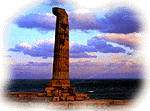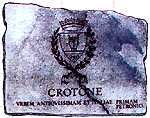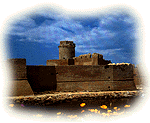 |

|
|
AN OUTLINE OF HISTORY |
|
| According to the most reliable historic tradition, Crotone was founded in about 708-709 by a nucleus of Anchaean settlers coming from Achaia, in Peloponnesus, who were among the numerous emigrants from the Greek Coasts since the ninth century b.C.. After consolidating its position, Crotone started its expansion on the closer territories. On the Tyrrhenian coast it founded the old Terina, while in the South supported Caulonia's growth. Crotone had always got good friendship relations with this colony. In a federation with Sibari and Metaponto, Crotone took part to Sir's destruction and in about 550 b.C., after gaining hegemony against Skilletion, it started a military action against Locri Epizephiri and was defeated on the Sagra River. In this period, Crotone destroyed Cleta and took Tempsa under its hegemony. In about 530 b.C., Pythagora's coming deeply influenced its history reducing the negative consequences of the suffered defeat and taking part to the stronger adfirmation of the already existing town organizations, such as Alcameone and Democede's Scuola Medica and the Scuola Atletica (Athletic School), which since 588 to 480 b.C. had won 12 editions out of the 27 it had took part to in Olympia. The best of its Athletes was Milone, who won six times. After destroying Sibari in 510 b.C., Crotone grew the most important town in the Graecia Magna. Its southern borders came to Locri entries and the northern ones reached Agri's river, southern border of Metaponto's territory. In 460 Crotone extended its influence even upon Zancle and imposed it an allegiance. (Zancle-Messina). Crotone's power lasted until 380 b.C. when Dionisio the Old submitted it. Dionisio was Syracusa's tyrant. After Syracusa's occupation, which was 12 years long, Crotone was involved into the war between Pirro and Romans and then, during the second Punish War, it was occupied by the Brutii, Hannibal's Allied. In 194 a Roman Colony was moved to Crotone. Important byzantine fortress, since the first century of the Christian Era, it was the oldest diocese in Calabria. In 552 it was, unsuccessfully besieged by the Gothic, who were defeated by Belisario's byzantin fleet. In 568 it was sacked and razed to the ground by the Longobard from Benevento's dukedom. Crotone fell into the Arab's hands in 845 and then it was reconquered by the Byzantinen; in 1059 it was conquered by Roberto il Guiscardo. Under the Normans, Crotone had got the feudal title of countship and seen an enormous economic developmet which had continued even under the reign of Friederich II from Swabia. It was he the one who rebuilt the castle and the harbour raising Crotone to royaltown. After the Angevin coming, Crotone, which had remained faithful to Friederich II, fell into the hands of the Ruffo's feudal rule (1824) and, involved into the war against the Aragonese, it was sacked by Ruggero from Lauria in 1297. Under the Angevins, with Caltabelotta's peace (1302), Crotone became the most crowded town in Calabria and thanks to its intense harbour activity, was an important commerce centre for numerous groups of foreign traders and housed the most important and powerful Jewish community in Calabria. Under Antonio Centelles, viceroy of Calabria's dukedom, after his marriage with Enrichetta Ruffo, in the Baron's revolt background, it was besieged and occupied by king Alfonso d'Aragona in 1444 and was a royaltown again. Crotone kept its autonomy with the Spanish too in the viceroyalty (1503-1707). In order to reward it for the resistance opposed to the French, Charles V declared it "Fedelissima" and gave it particular privileges and exemptions. Givin preminence to its militar role, the Spanish turned Crotone into their main Calabria Fortress, giving it the task of controlling the territory and defending it against the Turks. After two centuries of Spanish rule, Crotone fell into the hands of the Borboni in 1734 and in 1799, taking part to the Partenopea Republic revolt, it planted the Freedom Tree, becoming in that the most important centre of the Jacobinism. The revolt was suppressed by Cardinal Ruffo who ordered the town sacking and the patriots execution in the castle battery. On the sixteenth of June 1844 at river Neto's mouth, the unloading of the Bandiera Brothers took place and this was the first sign of the Risorgimento, which in 1860 saw Crotone and Calabria annexed to Italy, the united Italy.
|
||



